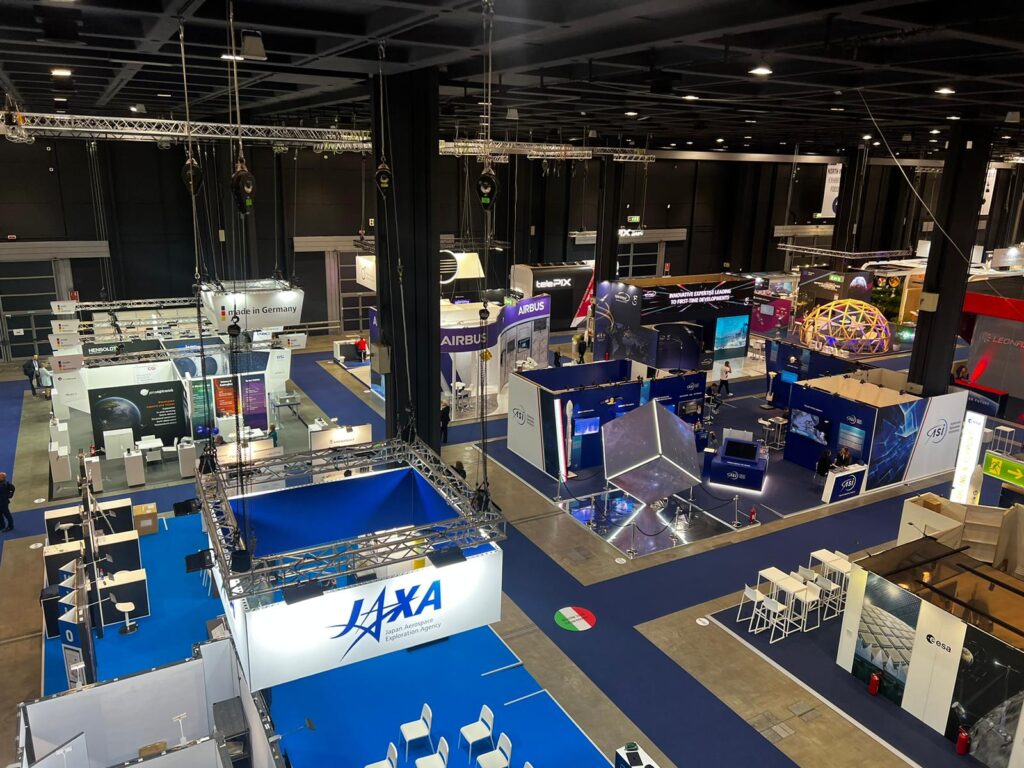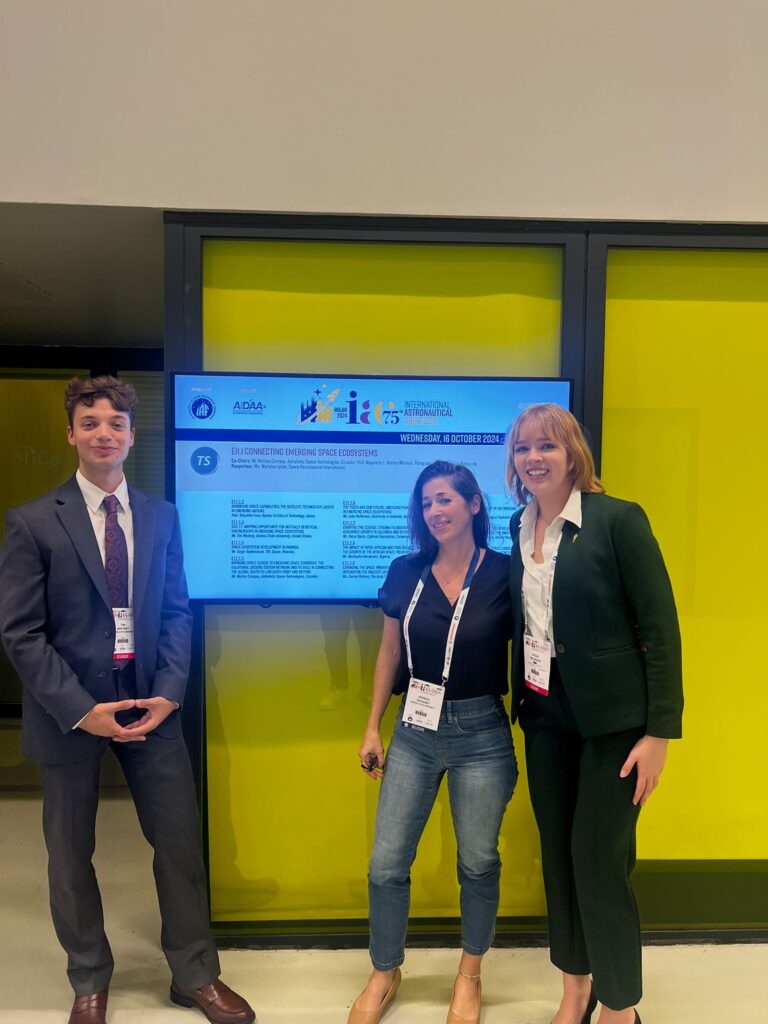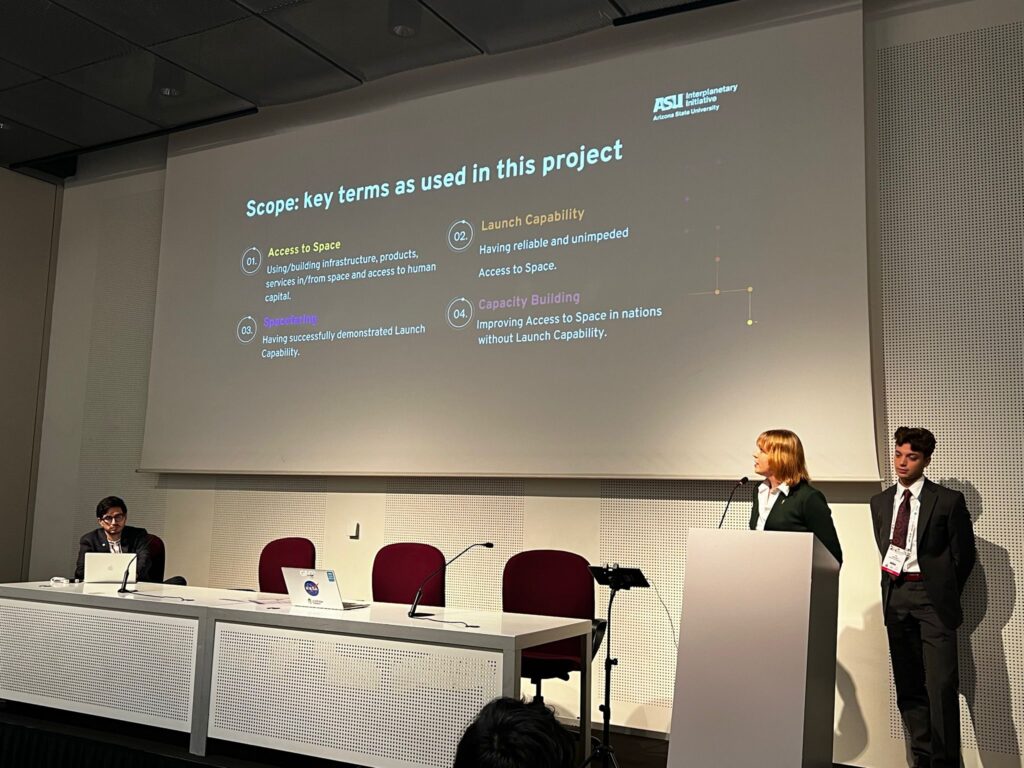This fall, ASU’s Interplanetary Initiative sent two recent graduates to Milan, Italy, to attend the 75th International Astronautical Congress (IAC). Joined by Interplanetary Initiative Director Jessica Rousset, Tim Whitney Jr. and Kylie Wetnight successfully presented their research conducted through the Interplanetary Initiative Undergraduate Research Scholars Program (IIURSP) addressing the Big Question: How can we accelerate achieving the UN SDGs through commercially led capacity-building partnerships with emerging spacefaring nations?
United Nations Sustainable Development Goal #17 (Partnerships for the Goals) is critical for emerging spacefaring nations to leverage space in combating climate change and achieving their SDGs by 2030. Collaboration between the commercial space sector, established spacefaring nations, and academia is key to enabling this access. The project, titled Partnership Motivation Index: a novel framework for space capacity building, is a collaboration with the UN Office of Outer Space Affairs (UNOOSA) and the Space Foundation that explores the drivers and barriers of commercially led capacity-building partnerships in emerging spacefaring ecosystems.
The team shares their research and experiences from the 75th International Astronautical Congress (IAC) 2024.

Contributor: Kylie Wetnight
Current professional title: Analyst at Prosono
Short bio: Hi! My name is Kylie Wetnight, and I am a recent graduate of Arizona State University and Barrett, The Honors College, where I earned a degree in Business (Global Politics) and a certificate in Cross-Sector Leadership. Currently, I work as an Analyst at Prosono, a strategy consulting firm based in Denver, CO. At Prosono, we are a team of social impact engineers dedicated to helping businesses, government entities, foundations, educators, nonprofits, and civil society amplify and accelerate their positive impact on humanity and the planet.
My journey with the Interplanetary Initiative (II) began in 2021 when I helped co-found the ASU Space Student Ambassadors program. Recognizing a lack of aerospace opportunities for non-engineering students, I worked with II to build the foundation for a program that would create opportunities for undergraduate students from any and all majors, years, and campuses. For the next two years, I proudly represented II as an ASU Space Student Ambassador, connecting industry leaders with undergraduate ASU students.
Through my ambassador role, I heard about this project. What sparked my interest was the ability to make a difference in the international relationships within the aerospace industry. I was curious about what partnerships with emerging spacefaring nations looked like and how we could foster stronger connections between established space entities and emerging spacefaring nations.
Beyond my professional and academic pursuits, I spend my free time traveling and listening to music. Over the past two years, I’ve visited 21 countries. Exploring new places and meeting people from diverse backgrounds energizes me, and I’m always eager to learn from the stories and cultures I encounter along the way.
Contributor: Tim Whitney
Current professional title: Sustainability Coordinator
Short bio: I’m a recent graduate from Arizona State University with a degree in business sustainability from the W.P. Carey School of Business and was a Barrett Honors College undergraduate where I did my thesis on “Champions of Sustainability: A Cross Sector Analysis of the Winning Strategies”.
I currently work full-time at Goodwill with their sustainability team but I am also a co-founder of Circular Earth, a small business utility consultancy focused on independent coffee houses. I have a business mind, a mission heart, and the spirit of an entrepreneur who doesn’t need permission to make a real impact. My dream is to start my own business or revitalize an existing one that I can lead for life.
I feel I was a good fit for the project as I have extensive knowledge and diverse relationships in the space industry due to co-founding the Space Business Association, I leaned on my student background implementing in real world sustainability tools and I had a great recommendation by Dr. Timiebi Aganaba who first introduced me to “space sustainability” through an African lens.
My most passionate hobby is training MMA. I love to cook, shoot street photography, and I’ve been an outdoorsman for many years.

What drew you to this research project, and can you elaborate on the big question you are aiming to answer?
Kylie: What drew me to this research project was the ability to make a difference in the international relationships within the aerospace industry. This project seeks to identify why or why not space entities and emerging spacefaring nations engage in partnerships and how we can accelerate achieving the UN SDGs through these partnerships. I saw an opportunity with this project to ensure that all the voices that are not always heard, particularly those of emerging spacefaring nations, are included in the conversation about the future of the space industry. It also presented a chance to bring these nations onto the radar of established space entities, fostering greater global collaboration in the industry.
Our big question, “How can we accelerate achieving the UN SDGs through commercially led capacity-building partnerships with emerging spacefaring nations?“, aims to uncover strategies for advancing the UN Sustainable Development Goals (SDGs), particularly SDG-17, through partnerships. Collaborating with emerging spacefaring nations offers two key benefits to established space entities: 1) Fresh perspectives on the aerospace industry, informed by their unique experiences and shorter history in the field; and 2) Innovative solutions for achieving the UN SDGs, driven by the diverse viewpoints and creative approaches that international partnerships bring
Tim: We had the chance to make a difference through our hard work. For me that was the motivating factor beyond all else. My interpretation of our project “big question” was, “Can academia make a difference in the African space sector?” Today, I believe we’re on track to answer our big question, not for ourselves, but for the stakeholders. We’re in good hands under Jessica Rousset.
How did you individually contribute to advancing this project?
Kylie: I served as the team’s student lead, where I took on the responsibility of scheduling and leading our student meetings and identifying weekly deliverables. In addition to my role as student lead, I simultaneously worked on my honors thesis, which was rooted in our research. With the support of my team, I explored the question: “What are the mechanisms to close gaps in capacity-building within emerging spacefaring ecosystems, and how do commercially led partnerships help advance this goal?”
Tim: My largest contribution was to author the original framework of the “Partnership Motivation Index” (PMI), our novel tool to answer our “big question”.
Why was IAC the perfect stage for sharing and advancing this research?
Kylie: IAC was the perfect stage for sharing and advancing this research because of the presence of numerous international space agencies and industry experts. Walking into the conference, you were greeted with the exhibition hall where representatives from most space agencies, big and small, filled the floor space. Some of the space agencies present included NASA (National Aeronautics and Space Administration), the European Space Agency (ESA), the United Arab Emirates Space Agency (UAESA), the United Nations Office for Outer Space Affairs (UNOOSA), the Turkish Space Agency (TUA), the China National Space Administration (CNSA), and the South African National Space Agency (SANSA) – even the Italian President was there! Beyond the exhibits, industry experts were actively engaged throughout the event. We had the opportunity to attend speaker sessions and workshops, where we gained insights into the current state and future projections of the space industry. These sessions also allowed us to hear from experts on topics closely aligned with our research.
Tim: Our session room at IAC was full of the most relevant stakeholders to our project. It was a stage in front of the world. Not just the “developed” world. We immediately received affirmative feedback. The presentation after us, a private Rwandan Czech satellite collaboration, said that the session should “ think more like the people from ASU”. We exchanged contact information and survey data from international attendees for our PMI model. We collected a mind blowing amount of helpful data.

What was the most impactful moment for you at IAC, personally or for the project?
Kylie: The most impactful moment for me at IAC was connecting with others engaged in similar work. One of our biggest challenges throughout this project has been finding comparable initiatives and identifying people from emerging spacefaring nations to collaborate with. After our presentation, several attendees approached us to share their own projects and insights. We had the opportunity to connect with representatives from PwC, Ispace, IAC organizers, and other students conducting similar research. These interactions made me feel part of a larger, collaborative community and left me even more excited and energized about the future of this project. The wealth of resources and collective expertise coming together to tackle this challenging question was truly inspiring.
Tim: The Q and A portion of our presentation was the first time a large audience saw our work. It felt like pass or fail. International stakeholders questioned us out of genuine curiosity, and we had great answers. At that moment I knew that our hard work paid off. We were on the same page, if not a page ahead, of the world’s brightest emerging space ecosystems thinkers. We could see it in their smiles.
What achievements from the work so far are you most proud of, and why?
Kylie: I am most proud of the strong foundation our team has built for this project. A year ago, we had a big question but little direction on how to begin answering it. Over the past year, the two student teams involved have not only established a solid groundwork for the project to continue but have also started sharing our findings publicly and seeking input from others—something that takes both courage and collaboration. Beyond laying this foundation, I’m proud of the diverse perspectives and voices that have shaped this work. Seven students from seven different majors and backgrounds came together to tackle this challenge. I’m continually impressed by how we combined our unique knowledge and skills to move the project forward.
Tim: We cut through a jungle narratives and ambiguity to create a foundation of practical research that will engage the global space ecosystem for years to come. We are building a new path to global space benefit. People around the world are routing for us to succeed and broadcast our findings. We are approaching fulfilling an unmet need for the established and emerging space economies.
What challenges did you encounter and what did you learn from them?
Kylie: Our biggest challenge was navigating the lack of clear direction in our day-to-day and week-to-week tasks. Starting this project from a big question meant we had to figure out our smaller objectives as we went along. During the first six months, we operated with an entrepreneurial spirit, defining our goals through trial and error and learning from our mistakes. As a team, we developed the skills to be research entrepreneurs, building structure from scratch. Along the way, we learned how to think creatively, communicate effectively, and adapt to changing circumstances.
Tim: It was difficult to have multiple “bosses” during our project. We had interests from the Interplanetary Initiative, UNOOSA, Space Foundation, and more- all with a slightly different optimal outcome for our research. We learned how to boil down the most material data and perspectives to cut through the noise.
Looking back, what was the most valuable skill, idea, or perspective you gained from working on this project? How has it shaped you as a young professional?
Kylie: Adaptability. I learned how to be adaptable in every way. I learned to adjust to working with a team that brought diverse understandings of the space industry and varied approaches to project management. Balancing this project with my full workload and class schedule taught me how to prioritize and manage my time effectively, especially since my involvement was primarily voluntary. I also had to adapt when our methods didn’t yield the data we needed, finding alternative approaches to move forward. Finally, I learned to incorporate feedback from stakeholders and integrate new findings into our work as the project evolved.
Tim: Persistence. Our research hit multiple roadblocks that at first felt impossible to navigate. A third way through, we completely changed our approach. We had to go back to square one and question our assumptions. We defined key terms ourselves. I learned to systematically root out ambiguity to communicate clearly to parties across the global space ecosystem.
What is next for this research? What are you most excited about the future of the project and do you plan to stay involved?
Kylie: The next step for this research is to refine the Partnership Motivation Index (PMI). While we’ve built a strong foundation for the model, the focus over the next few months will be on clearly defining each motivation and establishing precise definitions. Once the PMI model is refined, the team will move into the testing phase, aiming to finalize the model by the end of 2025. I’m excited to see the model come to life through its practical application in the future! I plan to stay involved as a project advisor by supporting the onboarding of new student researchers and serving as a resource for any questions they may have along the way. We’ve laid a strong foundation for this project, and I can’t wait to see how it evolves and thrives in the years to come!
Tim: Next, we put our Partnership Motivation Index into action. We’ll let outside experts test our model. We have some refining to do in the meantime. Long discussions to be had and homework to be done. I’ll be there to help onboard students primarily. Mostly, I’ve done my part and will standby as a critical observer. I also plan on presenting the model if given further opportunities. What’s next if we succeed, big picture? A more globally beneficial space sector for everyone. We believe that emerging nations must have a seat at the space table. This research builds the business case for that belief.